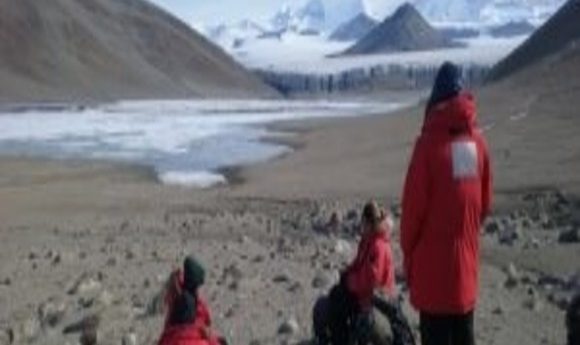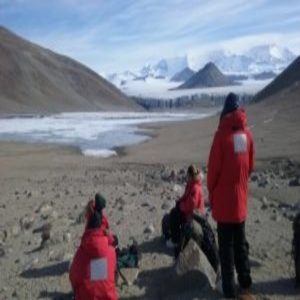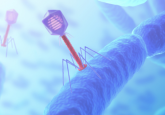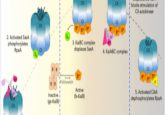Oragnisms in Antarctica: life in the coldest desert

In the coldest deserts of Antarctica, microscopic organisms thrive. What can Antarctic researchers learn about life in extreme conditions by studying organisms in Antarctica?

Antarctic researchers pause to contemplate the beautiful landscape in front of them.
Image courtesy of Walter Andriuzzi
The starkly beautiful yet harsh landscape of Antarctica—with its towering mountains covered in untouched snow, glacial plains reaching across the horizon, rocky stretches of land under the glaring sun—may seem barren at first, unable to support much life. Certainly, no flourishing forests can be found in the polar deserts of Antarctica. But with a closer look, some of the coldest deserts in Antarctica—frozen and devoid of moisture—teem with microscopic life.
Many researchers want to take that closer look and investigate the diverse organisms that somehow not only survive, but also thrive in these challenging conditions. “You never know what you’re going to find,” said Belinda Ferrari, an investigator at UNSW in Sydney, Australia, who studies microbial life in eastern Antarctica.
Researchers like Ferrari are continuously surprised by the ingenious mechanisms that support life in the Antarctic environment, and they are especially interested in understanding how life evolved to cope with the most extreme conditions. On another level, these Antarctic organisms may even provide clues into how life could potentially survive away from Earth.
Surviving on Thin Air
Ferrari’s group uses molecular biology techniques to analyze life forms in several desert sites in eastern Antarctica, including Robinson Ridge and Adams Flats. They collect samples of soil from these areas, and study bacteria in the soil using the latest genetic tools.
In a recent study published in Nature, Ferrari and her team reported that three groups of bacteria in the Antarctica soil survive on nothing but thin air. These bacteria are “primary producers,” responsible for converting inorganic molecules into organic forms for use by the bacterial community. Rather than performing photosynthesis like most primary producers, these bacteria use atmospheric trace gases—primarily hydrogen, carbon dioxide, and carbon monoxide—as their only energy and carbon sources.
For over ten years, Ferrari’s group collected microbial samples from the deserts of Antarctica. Then in the mid 2010’s, Ferrari decided to use shotgun sequencing to analyze the genomes of these microbial samples, and assembled the genomes of 23 types of bacteria. Some of these bacteria possessed genes Ferrari had never seen before, and she wondered if these genes conferred unique molecular features that allow these bacteria to survive.
“The shotgun metagenomics technique was what we used to develop the hypothesis, to discover this idea of what was happening in the soil, and then we used more traditional biochemistry to validate it,” said Ferrari.
Collaborating with Chris Greening, an investigator at Monash University who provided a biochemical perspective, Ferrari discovered that these unique genes code for hydrogenases, carbon monoxide dehydrogenases, and a unique variant of the carbon fixing enzyme RuBisCo that work together to extract energy from trace gases in the environment.
“It shows how little nutrients bacteria need to survive,” said Ferrari. “Given these bacteria are basically living on air, it opens up possibilities for life on other planets.”
To further investigate these strange organisms, Ferrari hopes to isolate and culture the bacteria. She is also interested in investigating whether bacteria from other parts of the world use similar techniques to survive on trace gases.
Lessons from Worm Hunters
Besides bacteria, microscopic animals like nematodes, rotifers, tardigrades, and springtails also make a living in Antarctic soils. Walter Andriuzzi, a postdoctoral researcher in Diana Wall’s lab at Colorado State University, hunts for worms and analyzes their behavior in Antarctic ecosystems.
Andriuzzi’s team has been collecting data on Antarctic nematodes for almost 25 years as they embark on many expeditions to Antarctica. The researchers first fly to New Zealand and then travel to the U.S.-operated McMurdo Station in Antarctica. From there, they take a half-hour long helicopter ride to the McMurdo Dry Valleys, their primary research site. They collect soil samples and bring them back to the research station, where they analyze some of them on the spot and ship others back to the U.S. for further analysis.
“Even though the McMurdo Dry Valleys look like Mars, there is soil and there is life there,” Andriuzzi said. He analyzes the abundance and diversity of different types of nematodes and other invertebrates in the soil samples and collects data on soil characteristics like pH, moisture, and salinity. He’s interested in seeing how these populations evolve over time as they respond to changes in their environment.
In a study recently published in Ecology, Andriuzzi and colleagues reported that climate change caused modifications in nematode populations between the 1990s and now. Since 2001, the McMurdo Dry Valleys have become more warm and moist, and have experienced a greater frequency of intense weather events.
“Overall, the animal community is shrinking rather than becoming more abundant. The negative response in the species that don’t like these warmer weather conditions is much stronger than the response of the other species,” said Andriuzzi. “There’s really no place on the planet where the effects of climate change are not felt.”
Ferrari echoed this sentiment. “Antarctica is one of the continents that’s experiencing rapid change in climate, and that’s a big focus area—to try to work out what’s going to happen to these microbial communities,” she said. “We always focus on the large organisms, but I think we need it for the small organisms too.”
Both Andriuzzi and Ferrari emphasized how important it is for researchers in Antarctica to work together to answer those questions. “You have to be collaborative—no one alone could do anything there,” said Andriuzzi.
These motivations have driven Andriuzzi in his research, but at the end of the day, he also points to another strong motivator: the sheer excitement of exploring a place where few people have ever walked. “You’re surrounded by just silence, the wind blowing in this huge expanse of ice,” he said. “It’s an incredible place to be. And very beautiful.”





